It’s a tradition older even than fish fries and soup suppers: every Friday in Lent, Catholics the world over gather to meditate on the Passion and death of Jesus in a devotion called the Stations of the Cross.
Some stand and kneel in their pews while the priest processes past the 14 stations with an altar server; other crowds move from one station to the next, inside a church or outdoors on a hill like Calvary. In other places, the tradition is for men and women to dress as the characters of the Passion and to re-enact the suffering and death of Jesus.
But the Stations of the Cross weren’t always a parish event or a devotion safely practiced from the comfort of your hometown. The Stations as we know them today are derived from a far more perilous act of worship: a pilgrimage to Jerusalem to walk in Jesus’ footsteps and pray through the Passion in the very place where he suffered it.
There’s a tradition that Mary herself used to pray the Stations of the Cross in Jerusalem after the Ascension of Jesus. Whether or not that’s the case, it’s certain that medieval pilgrims used to make their way to the Holy Land a few centuries later—journeying for months at great cost and great risk—in order to set foot on the land that Jesus had hallowed by his very presence. They would enter the holy city and seek out the places that were of importance in the life of Christ, particularly in his last hours.
There, in what tradition held to be the Upper Room, they could rejoice in the gift of the Eucharist and resolve to wash the feet of their brothers and sisters. In Gethsemane, they could lay their desires before the Lord and pray, “Not my will but yours be done.”
And on the Via Dolorosa they could walk alongside the suffering Jesus. They could shake their heads at Pilate’s cowardly condemnation, wondering when they, too, had ordered Jesus crucified in order to preserve their own comfort. They could imagine themselves taking up their own crosses beside Jesus. They could picture the Lord falling and falling and falling again, wonder at the pain Mary felt when she met her son, and pray for the grace to help others carry their crosses. With Veronica, they could promise to aid those who are suffering in shame. With the holy women, they could hear the Lord’s sorrowful warning of what was to come for those who did not follow him. They could turn away in shame as they imagined Jesus stripped of his garments, catch their breath when the hammer drove the nails into his flesh at the top of Calvary, and kneel in grateful anguish before the death of the Lord. Finally they could witness the pain and surrender of God’s sorrowful mother as she received his body, before walking down to the holy sepulcher to watch the Lord laid to rest, seemingly never to rise again.

Read more:
Stations of the Cross for busy people
The number of stations varied for many centuries, including dozens that would be unfamiliar to us and leaving out many of the traditional stations that make up the devotion today. The purpose of the pilgrimage wasn’t a strict observance of a ritual but an encounter with the person of Christ by drawing near to him in his suffering. For this, people would travel thousands of miles, knowing that some of them would die before they ever saw their homes again.
As travel to the Holy Land became more and more dangerous, those who returned to the Holy Land sought to introduce those who weren’t able to make the pilgrimage to this powerful method of prayer. So the Franciscans (to whom the sacred places of the Holy Land had been entrusted) began to erect roadside Stations in the 15th and 16th century, with the list of 14 stations as we know them today established by the 17th century.
The idea behind the Stations remains the same, though: to meditate on the last hours of Christ’s life, to see ourselves in Jesus, in his oppressors, his friends, and the jeering crowd. There are countless images of the Stations, each drawing attention to a different aspect of the suffering of Jesus, and any number of different texts to use for prayer. But the words and artwork aren’t the heart of the Stations, nor even the wooden crosses spaced around a church or wooded path or courtyard.
The heart of the Stations is the invitation to draw near to the suffering Christ, to walk beside him as so few of his friends did that ugly afternoon when he won our salvation. When we pray the Stations, we console the heart of Jesus and come to love him more fully as we better understand all that he suffered for love of us.
It’s no wonder so many millions have prayed this way over the years: what better gift could we offer our crucified Lord?

Read more:
The fascinating history of the “We adore you, O Christ” prayer from the Stations of the Cross

